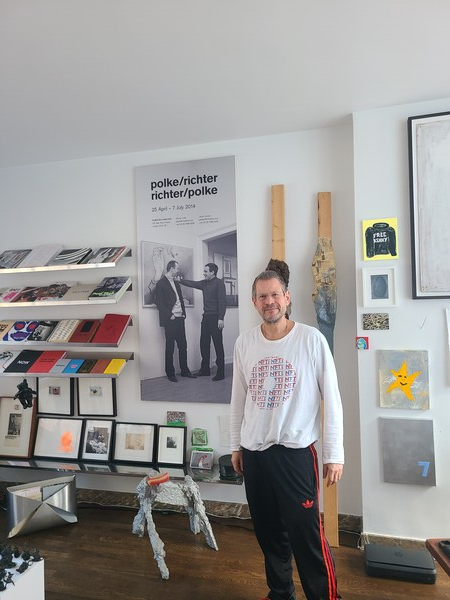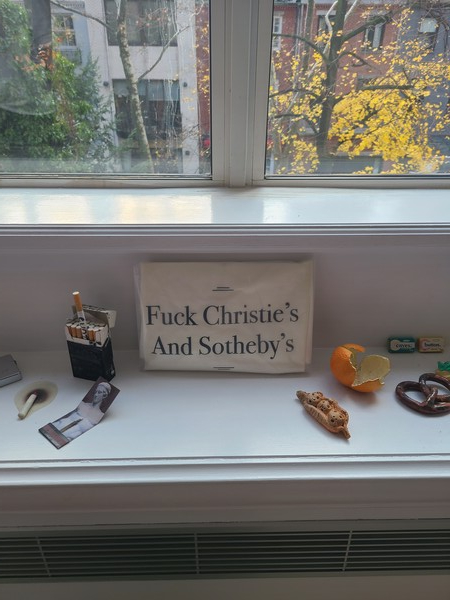
Writer, curator, lecturer and artist Kenny Schachter at his home in Manhattan, New York. Source: Felix Im
Writer, curator, lecturer, artist, NFT evangelist — Kenny Schachter is an art critic whose criticism is often directed at the art world itself.
“I’ll always consider myself an outsider in the art world. I’ve been fighting that community’s exclusionary mindset and attitude for the past 30 years.”
These days, however, he’s become the contemporary art world’s most vocal proponent of NFTs. A visit to Schachter’s personal website reveals an entire library of NFT-related writings.
I met with Schachter at his home in Manhattan’s Upper East Side on a calm December day. The calendar says winter but the outside scenery looks more like fall. Yellow leaves still grace the trees that line the quiet street where Schachter lives. The surrounding neighborhood looks like it’s ready to appear in a Woody Allen film. We had both recently visited Miami for Art Basel 2021, where Schachter exhibited some of his work.
Schachter got into art relatively late in life. Up until his 20s, he says he didn’t even know galleries existed.
“I had to visit Sotheby’s Andy Warhol estate sale in the 80s to even discover that art didn’t go directly from the artist to the museum. I was like an idiot savant. Had no idea galleries existed.”

Schachter’s bedroom. Source: Felix Im
Interviewing Schachter is tricky because once he gets going on a topic it’s hard to stop him. Before we tread too deeply into art territory I ask him to lay down some basic background information.
“I studied philosophy and political science. I then went to law school with zero intention of pursuing any career in law, but I couldn’t do anything with a philosophy degree and I needed time.”
Within the first year of law school, he stopped going to class. He worked a series of jobs while telling his employers he was in night school, even though his school didn’t offer a night school. He studied for the exams on his own and passed them — even passed the Bar.
His method of studying for the Bar was to type around a thousand pages of handwritten notes into a computer.

Schachter’s walls are covered in art. Source: Felix Im
Although not formally a professor, Schachter has taught art history at numerous institutions, including the School of Visual Arts, New York University, Columbia University, and the New School for Social Research.
“I somehow managed to con my way into a teaching job at the New School. I was hired on probation because I had no graduate degree in the subject I was teaching, but I did have a graduate degree, which was a prerequisite. So I got hired for a six-month contract.”
The dean who hired him then left, but Schachter was still on the books as an adjunct professor. He hasn’t stopped teaching since.
Schachter says he teaches primarily to learn, and he writes to get a deeper appreciation and understanding of things.
“I could teach anyone off the street everything there is to know — more or less — about contemporary art in a few months, because I had to teach myself everything.”
Schachter says he has always loved and embraced technology, although he “couldn’t get his speakers and computer to turn on this morning.” He made his first digital animation in the early 90s.

Source: Felix Im
Even if he’s not fluent in the language of technology, he’s always enjoyed using it. He’s not a coder or a programmer. Just because you like to eat doesn’t mean you like to cook, he says.
“I’ve always been fascinated by the culture of technology and how it affects art, politics, and economics.”
Schachter always tries to be an early adopter. Whenever a new technology presents itself, he likes to jump right in and see what it’s all about. When he discovered NFTs a year and a half ago, it was the same thing.
“I’ve spent the past 30 years learning about art history. When I found out about NFTs, I stopped everything and started my life over again.”
What about NFTs drew him in so quickly?
“People often ask me, ‘What are NFTs?’ And my answer is they’re nothing. They’re just smart contracts piggybacking on the Ethereum blockchain.”
This response confuses me. So why the obsession with NFTs? Your website is plastered with articles about NFTs.
“NFTs themselves are nothing. NFTism, however, is everything. It’s the culmination of everything in my career.”
NFTism, a term that Schachter has coined, represents the potential behind NFTs, the communities built around them. NFTism is how the technology of NFTs changes the art world. It’s a revolution in the way people view art and art exchange. It’s a reinvention of concepts like “collectible” and “value.”

Source: Felix Im
Upon discovering NFTs in 2019, Schachter got in touch with Nift Gateway. At the time, “people weren’t trying to kill each other to get on the platform.” He minted an NFT which earned him around $4,000.
The experience set off an explosion in his mind. He immediately started writing that NFTs were going to impact the art industry in a major way.
“I’m basically the first person in the contemporary art world that not only embraced NFTs but saw how they would impact the traditional art system in a way that, in my mind, is nothing short of revolutionary.”

Source: Felix Im
Social media, Schachter says, allowed people to instantly communicate visually across geographical boundaries for the first time. However, Instagram isn’t transactional. Artists could display their work in this new way, but they still had to rely on old-fashioned systems to sell their work. They were still reliant on the old gatekeepers. By adding a transactional element, NFTs have given artists the opportunity to completely liberate themselves of the old system.
Through his writing, teaching and his NFT evangelism, Schachter says he’s shepherded thousands of people into the space. People send him emails every day telling him how he inspired them to enter the NFT world.
Although an expert on contemporary art and art history, Schachter has always been an outsider in the art world. He has consistently written and spoken about the art industry’s exclusionary and elitist tendencies. In one interview, he said galleries are “even more conservative than the floor of the New York Stock Exchange.” Schachter’s criticism of the art world has even gotten him death threats. He sums up the experience as such: “People try to kill me because I tell the truth.”
“The art world is closed. It doesn’t foster innovation.”

Source: Felix Im
It was the auction house Christie’s that sold Beeple’s work, not a gallery. Schachter says Beeple would have never been accepted by the fine art world. In his view, galleries are restricted by their own elitism and prejudices, while auction houses will sell anything and everything so long as they can make money off it, which made them open up to NFTs.
“Galleries don’t even have the interests of their own artists at heart. It’s all about controlling access. Who gets to buy, who gets to show, who gets to sell.”
To illustrate, Schachter tells me that galleries will often block outside opportunities presented to artists they represent if those opportunities detract from their own prestige.

Source: Felix Im
In the traditional art world, everybody wants what’s already in demand. “It’s more difficult to sell a piece of art that costs $6,000 than it is to sell one that’s worth $150,000,” Schacther says. Nobody wants to depart from what’s hot.
“In the traditional art world, it’s worse to be ahead of the times than to be behind them.”
NFTs, however, allow any kind of art to be sold, regardless of whether it’s trendy or not.
I ask Schachter why the art world has become so restrictive and close-minded. Isn’t art supposed to be about openness and creativity?
He says there are many factors, but one is that the art market is relatively small. He estimates its yearly revenue is around $65 billion a year. “Companies like Apple or Google probably make that much money before I go to the bathroom in the morning.” The market therefore operates on a zero-sum model, where anyone who advances does so at another’s expense. This sort of rat-race mentality retards innovation.

Source: Felix Im
Schachter reminds us that Apple’s software started off as a closed architectural system before realizing Jobs opened it up to developers to entice them to create more applications. Galleries will eventually be forced to embrace NFTs.
“In the future, every major gallery will have some sort of dedicated NFT space. If they don’t change. they’re going to become obsolete.”

Source: Felix Im
As an outsider in the art world, Schachter had to rely on crafting his own voice. He built up his own audience through pieces published on
sites like Artnet, as well his own website, where he publishes pieces constantly.
“The art world is all about barriers and accessibility. They never let me in, so I’ve always had to find alternative ways to exhibit my work. I don’t rely on anyone for anything.”
So when a gallery offered to represent Schachter so he could exhibit at Art Basel 2021 in Miami, Schachter found it ironic and hilarious. The moment he finally becomes financially independent from selling his art as NFTs, the traditional art world that had snubbed him for so many years offers to represent him.
“I had zero intention of selling at Basel. That was just my big ‘fuck you’ to the art world.”

Source: Felix Im
At the end of the interview, Schachter showed me around his townhouse. Five floors of Manhattan townhome all covered in art. It’s hard to describe. He doesn’t seem to believe in blank walls. He says he wants to be soaked in art from the moment he wakes up to the moment he goes to bed.
Schachter says he once worked with Chelsea and Westminster Hospital in London on a clinical study that determined that art has healing properties. After commissioning artists for work to hang in their spaces, the hospitals observed that patients required less medication and had shorter hospital stays. Art soothes the soul, which helps the body recover.
“It’s the reason why dogs are in old-age homes. It reduces anxiety.”

